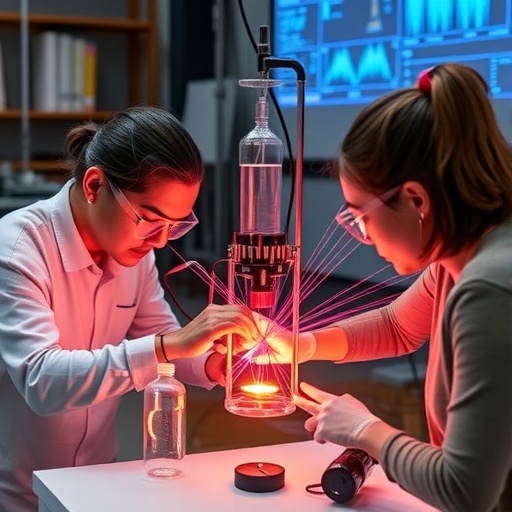In a groundbreaking study published in the journal Sports Engineering, researchers have unveiled a novel testing methodology utilizing an instrumented human head replica. This innovative approach aims to enhance our understanding of the impacts that athletes experience during sports activities. With the increasing focus on head injuries in sports, particularly concussions, the necessity for effective testing and measurement methodologies becomes ever more pertinent. The study was conducted by a team comprising E. Baldoin, G. Zullo, P. Carraretto, and others, and represents a significant advancement in impact testing research.
The researchers designed an experimental setup that combines numerical simulations with practical testing, allowing for a more comprehensive analysis of head impacts. The instrumented head replica is equipped with advanced sensors designed to gather precise data during impact events. This state-of-the-art technology provides valuable insights into the forces and accelerations experienced during collisions, which may contribute to injury mechanisms in sports. By bridging the gap between simulated conditions and real-world impacts, the researchers are striving to improve safety standards in athletic environments.
An essential feature of this study is its emphasis on the realism of the impact scenarios tested. The researchers developed a range of impact conditions to simulate various sports-related activities, from contact sports like football and rugby to individual sports that may involve falls or collisions. By mimicking these conditions, the researchers hope to generate data that accurately reflects the types of incidents athletes face regularly. This realism not only enhances the validity of the findings but also increases the potential for translating the results into practical safety measures.
Furthermore, the integration of numerical methodology alongside experimental data allows for extensive analysis and modeling of head impacts. By utilizing computational simulations, the researchers can predict the likely outcomes of different impact scenarios, thus informing potential design improvements for protective gear. This predictive capability can lead to the development of helmets and other protective equipment that are better equipped to mitigate risks, ultimately aiming for increased safety for athletes at all levels.
In the landscape of sports safety, the importance of data-driven decisions cannot be overstated. This study’s findings possess the potential to influence equipment manufacturers and sporting organizations, urging them to incorporate scientifically validated data into their design processes. By focusing on developing gear that is responsive to the unique dynamics of various sports, stakeholders can contribute to the overall health and safety of athletes, potentially reducing the incidence of head injuries.
The researchers also acknowledge the limitations of their study, as the complexity of human anatomy and the multifaceted nature of head injuries pose challenges that cannot be fully addressed with current methodologies. The instrumented head replica, while advanced, is still a simplified model of a human head, which means that certain biofidelic responses may not be accurately captured. Consequently, ongoing research and collaboration with neuroscientists and medical professionals are crucial to enhance prediction models and ensure that findings can realistically translate into real-world applications.
The societal implications of this research are profound, given the rising awareness of head injury risks in sports. With high-profile cases of concussions grabbing headlines, sporting organizations are pressured to prioritize athlete safety. By providing a more thorough understanding of the mechanisms behind head impacts, this study aims to empower these organizations to make evidence-based changes to their protocols and protective standards.
In addition to contributing to enhanced safety standards, the study also opens new avenues for future exploration in sports engineering. As the team continues to refine their methodology, it is expected that further research will delve deeper into long-term impact effects and potential chronic conditions stemming from repeated head trauma. Understanding these elements will be critical in formulating not only the design of sports equipment but also the protocols surrounding athlete recovery and wellness.
Furthermore, the collaborative nature of this research demonstrates the value of interdisciplinary approaches in solving complex problems. By bringing together experts from fields such as biomechanics, engineering, and sports science, the researchers promote a holistic understanding of impact-related injuries. This collaboration serves as a model for future studies, encouraging further cross-disciplinary initiatives that address pressing challenges in sports safety.
As discussions surrounding athlete welfare continue to evolve, the implications of the findings from this research extend beyond the sporting realm. Various industries involved in safety gear design, automotive engineering, and even military applications can benefit from the insights obtained through this innovative testing methodology. By leveraging the advanced data generated through this study, a ripple effect is anticipated, leading to safety advancements across a range of fields.
In conclusion, the development of a coupled experimental–numerical methodology utilizing an instrumented human head replica signals a new era in impact testing. As the study demonstrates the potential for significant advancements in sports safety, its influence may be felt well beyond the confines of the sports field. The implications for protective gear design, safety protocols, and interdisciplinary collaboration in addressing complex safety challenges are profound. As this research continues to evolve and garner attention, its findings lay the groundwork for future innovations aimed at protecting athletes and enhancing their overall experience in sports.
Subject of Research: Development of a coupled experimental–numerical methodology using an instrumented human head replica for impact testing.
Article Title: Development of a coupled experimental–numerical methodology using an instrumented human head replica for impact testing.
Article References:
Baldoin, E., Zullo, G., Carraretto, P. et al. Development of a coupled experimental–numerical methodology using an instrumented human head replica for impact testing. Sports Eng 28, 38 (2025). https://doi.org/10.1007/s12283-025-00520-9
Image Credits: AI Generated
DOI: https://doi.org/10.1007/s12283-025-00520-9
Keywords: head impact testing, sports safety, protective gear, concussion research, experimental methodology.




